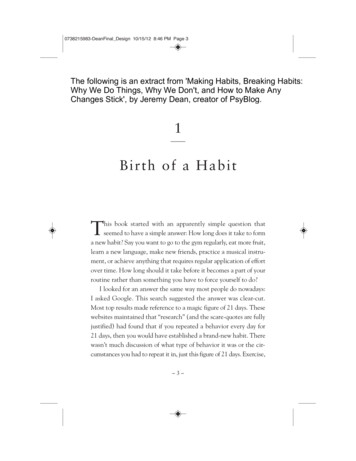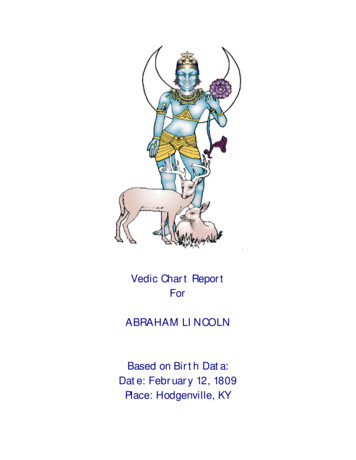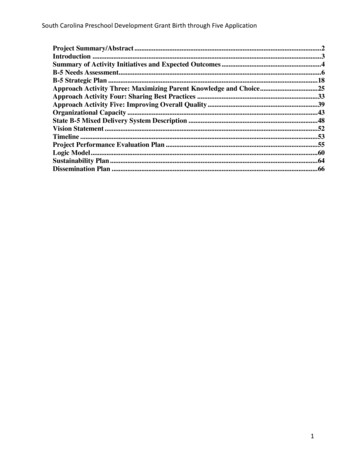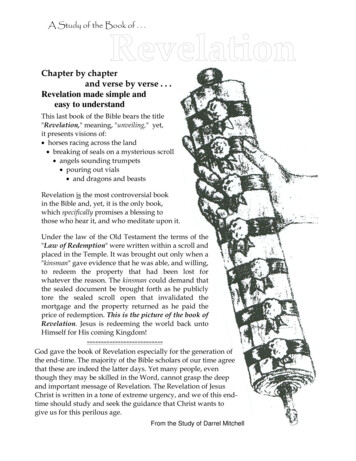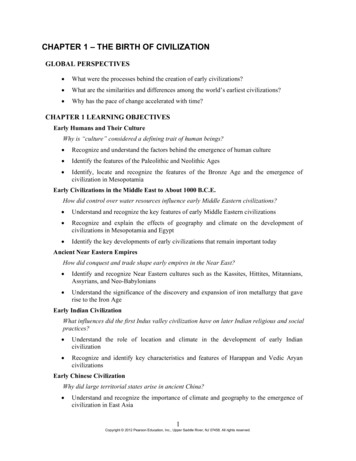
Transcription
CHAPTER 1 – THE BIRTH OF CIVILIZATIONGLOBAL PERSPECTIVES What were the processes behind the creation of early civilizations? What are the similarities and differences among the world’s earliest civilizations? Why has the pace of change accelerated with time?CHAPTER 1 LEARNING OBJECTIVESEarly Humans and Their CultureWhy is “culture” considered a defining trait of human beings? Recognize and understand the factors behind the emergence of human culture Identify the features of the Paleolithic and Neolithic Ages Identify, locate and recognize the features of the Bronze Age and the emergence ofcivilization in MesopotamiaEarly Civilizations in the Middle East to About 1000 B.C.E.How did control over water resources influence early Middle Eastern civilizations? Understand and recognize the key features of early Middle Eastern civilizations Recognize and explain the effects of geography and climate on the development ofcivilizations in Mesopotamia and Egypt Identify the key developments of early civilizations that remain important todayAncient Near Eastern EmpiresHow did conquest and trade shape early empires in the Near East? Identify and recognize Near Eastern cultures such as the Kassites, Hittites, Mitannians,Assyrians, and Neo-Babylonians Understand the significance of the discovery and expansion of iron metallurgy that gaverise to the Iron AgeEarly Indian CivilizationWhat influences did the first Indus valley civilization have on later Indian religious and socialpractices? Understand the role of location and climate in the development of early Indiancivilization Recognize and identify key characteristics and features of Harappan and Vedic AryancivilizationsEarly Chinese CivilizationWhy did large territorial states arise in ancient China? Understand and recognize the importance of climate and geography to the emergence ofcivilization in East Asia1Copyright 2012 Pearson Education, Inc., Upper Saddle River, NJ 07458. All rights reserved.
Identify and describe the key features of Shang and Zhou civilization Identify and analyze key concepts such as the Mandate of HeavenThe Rise of Civilization in the AmericasHow did agriculture influence the development of civilizations in Mesoamerica? Understand, recognize and be able to explain the unique characteristics of civilizationaldevelopment in the Americas Locate and identify the four major areas of dense settlement in the Americas Understand terms and era categorizations such as Early Horizon, the Early IntermediatePeriod, the Middle Horizon, and the Late Intermediate PeriodCHAPTER SUMMARYChapter 1 explores the origins of civilization in the four major river valleys of the world fromprehistory to the establishment and utilization of written records. From perhaps 600,000 to 10,000B.C.E., people were hunters, fishers, and gatherers, but not producers of food. The chapter developsthe social relationships within prehistoric society and contrasts them with the changes dictated by thedevelopment of agriculture—the Neolithic Revolution. By about 3000 B.C.E., writing began todevelop in the Tigris and Euphrates river valleys in Mesopotamia and soon thereafter in the Nilevalley. Somewhat later, urban life developed in the Indus Valley of India and the Yellow River basinin China. This development did not negate the nomadic lifestyle of many groups, and the constanttension between nomadic and settled lifestyles was an important aspect of early historicaldevelopment.The Sumerian culture developed in southern Mesopotamia, near the Persian Gulf. The Sumeriansestablished the social, economic, and intellectual foundations of Mesopotamian culture and werefollowed by the Akkadians and Babylonians who united the region. There were importantadvancements in writing (cuneiform), law, education, and religious thought. For example,Hammurabi’s code (ca. 1750 B.C.E.) is the fullest and best preserved ancient legal code and reveals asociety strictly divided by class, yet bound together by harsh precepts that demanded discipline andorder. The civilization, however, was generally pessimistic in outlook, an observation based mainlyon the evidence of religious sources that depict a gloomy picture of the afterworld as a place ofmisery.Egyptian civilization developed in a different manner and remained, for the most part, optimistic inits long history. Geographically, the Nile River unified the region and made agriculture possible whilethe desert afforded the protection from nomadic invaders necessary for the evolution of centralizedpolitical authority. Pharaonic authority was reflected in the pyramids of the Old Kingdom and theimperialism of New Kingdom dynasties.After an overview of Egyptian religion and the roles of women and slaves in Egyptian society, thechapter continues with an account of the contributions of the Hittites (military counterweight to Egyptianambitions), early Anatolians (smelting of iron), Kassites (promotion of Babylonian culture), andespecially the Assyrians who established an empire that by 665 B.C.E. included Palestine, Syria, andmuch of the area extending to the Persian Gulf. This empire kept out nomadic barbarians on the frontierto permit the civilized Middle East to at least maintain its advancements in the various areas. TheAssyrian Empire fell because of internal revolutions and a defeat by the Neo-Babylonians in 612 B.C.E.Indian civilization developed in a unique fashion as the early urban literate culture was supersededby the Aryan culture after a few hundred years. The chapter examines the development of the earlyIndian and Aryan cultures separately. The Indus or Harappan civilization developed in the region of2Copyright 2012 Pearson Education, Inc., Upper Saddle River, NJ 07458. All rights reserved.
modern Pakistan, and excavated sites dating from 2500–1500 B.C.E. show an unusual conformity inthe culture based upon similar city layouts, building construction and flood walls. Reasons for thedecline of this civilization are open to speculation, but could involve abnormal flooding and/or theappearance of warlike nomads around 1800 B.C.E.The Aryan culture that “refounded” Indian civilization about 1500 B.C.E. did not develop an urbanculture, but depended on stock breeding and agriculture. Our understanding of these people ispartially based upon the Vedic ritual texts that offer general inferences about religion, society, values,and thought in early Aryan India. The chapter characterizes the civilization in each of these specificareas.Early Chinese civilization developed about 4000 B.C.E. in the Yellow River valley. The politicalinstitution was the city-state and the largest of these areas was the capital of the Shang Dynasty(1766–1050 B.C.E.). This capital migrated a great deal; therefore, the great monumental architectureof Mesopotamia or Egypt did not develop in China. The Shang civilization developed a system ofwriting that has been preserved primarily on oracle bones. Bronze appeared in China about 2000B.C.E., much later than in Mesopotamia or India. This later Bronze period developed into the ZhouDynasty (1050–771 B.C.E.), which continued the basic structure created by the Shang Dynasty. TheZhou Dynasty, in order to legitimate their rule, created the concept of the Mandate of Heaven, aconcept subsequently evoked by every dynasty down to the 20th century. The Western Zhou dynastywas overrun by barbarians in 771 B.C.E. and fled 200 miles to the east. The Eastern Zhou dynastywas never able to recover its lost authority, and smaller states within the boundaries of its realmentered into defensive alliances against the power of encroaching territorial states. From 401–256B.C.E., interstate stability disappeared as power was contested by eight or nine great territorialcontenders. The rise of these territorial states at the expense of dynastic rule was due to the expansionof population and agricultural lands, the development of commerce, and the rise of a new armycomposed of conscripted foot soldiers and professional commanders.The chapter concludes with a section on the prehistoric era in the Americas. Four areas ofrelatively dense settlement emerged in the Americas: Puget Sound (depended on fish, rather thanagriculture), Mississippi valley (based on maize agriculture), Mesoamerica, and the Andean region ofSouth America. The latter two saw the emergence of strong and long-lasting states. The achievementsof these civilizations are especially remarkable in light of the technologies that they lacked. They didnot use the wheel for transportation, had not invented the plow, did not make extensive use ofmetallurgy, did not know about gunpowder, and did not have oceangoing ships. Their remarkableskills in pottery, weaving, sculpture, and architecture are most impressive. Chapter 13 examines theMesoamerican and Andean civilizations in detail.KEY POINTS AND VITAL CONCEPTS1. “Culture” and “Civilization”: The text defines culture succinctly: “the ways of living built up bya group and passed on from one generation to another.” Civilization is defined as a type of culturethat is characterized by “urbanism, technological adaptation, social complexity, long-distance trade,and symbolic communication.” Note that this is broader than some traditional defnitions thatrequire, for example, writing or the use of plows.2. Development of Government: As more people began living in the same area, various forms ofgovernment developed ranging from strong centralized monarchies (Hittites, Assyrians,Babylonians, Zhou, and Indo–Aryans), to the Sumerian, Harappan, and Shang city-states, to atheocracy in Egypt.3. Geography and History: Geographic determinism is an important factor in the uniquedevelopment of all four civilizations discussed in this chapter. The agricultural advantages of theIndus and Yellow River valleys proved essential to the progress of human civilization. In the3Copyright 2012 Pearson Education, Inc., Upper Saddle River, NJ 07458. All rights reserved.
ancient Near East, geographical influence on the development of particular civilizations is evenmore pronounced. Egypt was protected by deserts and the sea and nourished by the Nile, whichflooded regularly; it was less prone to invasion and hence more secure politically. Mesopotamia wasinvaded regularly, having no natural barriers; the Tigris and Euphrates rivers were difficult tonavigate and control, and they flooded regularly. The Mesopotamian civilizations are described asmore pessimistic than the Egyptian, which may reflect Egypt’s more defensible geography.4. The Neolithic Revolution: One of the most important transitions in human history occurred in onlya few Paleolithic societies. The development of agriculture and the domestication of animals forfood and material and the invention of pottery dramatically changed the way people lived andworked. Reasons for the shift to the age of agriculture remain unclear, but gradually populationincreased and societies became more organized and stable, often resulting in urban communities andthe attendant development of writing (about 3000 B.C.E. in the Near East and somewhat later inIndia and China). Because of Ice-Age game extinctions, American peoples had to rely on proteinfrom vegetable sources. One result was that their production of foodstuffs providing protein faroutpaced that of European agriculture. Approximate dates for the earliest Neolithic societies follow:A) Middle East (ca. 8000 B.C.E.) Based on wheatB) China (ca. 4000 B.C.E.) Based on millet and riceC) India (ca. 3600 B.C.E.) Based on wheatD) Mesoamerica (ca. 4000 B.C.E.) Based on maize5. Contributions: Religious development and the evolution of writing are of major importance to allearly civilizations. The development of monotheism by Akhenaton in Egypt had limited impact onearly evolution of religious thought. However, the Vedas and reference to divine will in both Indiaand China were of primary importance in the evolution of their respective societies. Monumentalarchitecture (pyramids, obelisks, temples, etc.) and the organization of empires (Egyptian,Assyrians, Shang, Aryan, and others) were important factors in the evolution of world history.PRIMARY SOURCE: DOCUMENTS IN WORLD HISTORY DVD-ROMText Sources Workings of Ma’at: “The Tale of the Eloquent Peasant” The Code of Hammurabi Syrian Government Documents: The Archives of Ebla Sumerian Law Code: The Code of Lipit-Ishtar Ptahhotep, from the Egyptian Book of Instructions Praise of the Scribe’s Profession: Egyptian Letter Mission to Byblos: The Report of Wenamun Marshall Sahlins, “The Original Affluent Society,” from Stone Age Economics Margaret Mead, from “Warfare is Only an Invention—Not a Biological Necessity” Liu the Duke and Tan-Fu the Duke, from the Shi Jing Lafcadio Hearn on Japanese Geisha: from Glimpses of Unfamiliar Japan Jane Goodall, from “The Challenge Lies in All of Us” James Cook, from Captain Cook’s Journal During His First Voyage Round the World Jack Harlan, from Crops and Man4Copyright 2012 Pearson Education, Inc., Upper Saddle River, NJ 07458. All rights reserved.
Hou-Ji, from the Shi Jing Hittite Law Code: excerpts from The Code of the Nesilim Hittite Land Deed Excerpts from The Epic of Gilgamesh Egyptian Diplomatic Correspondence: excerpts from The Amarna Letters Early Criminal Justice: The Nippur Murder Trial and the “Silent Wife” David Rindos, from “Symbiosis, Instability, and the Origins and Spread of Agriculture: ANew Model” Charles Darwin, “Cultivated Plants: Cereal and Culinary Plants” from The Variation ofAnimals and Plants under Domestication Ancient Egyptian and Hittite Voices: (a) letter from the Pharoah to Harkhuf the explorer;(b) Ramses III, “The War Against the Sea Peoples;” (c) Hittite soldiers’ oath Ancestor Worship: from the Shi Jing The Babylonian Chronicles, “The Fall of Nineveh Chronicle”Visual Sources The Standard of Ur Shang royal tomb Polynesian reed map Ozette whale fin Hominid tools Egyptian obelisks Dolmen of Kerhan Cuneiform t
Dynasty (1050–771 B.C.E.), which continued the basic structure created by the Shang Dynasty. The Zhou Dynasty, in order to legitimate their rule, created the concept of the Mandate of Heaven, a concept subsequently evoked by every dynasty down to the 20th century. The Western Zhou dynasty was overrun by barbarians in 771 B.C.E. and fled 200 miles to the east. The Eastern Zhou dynasty was .

